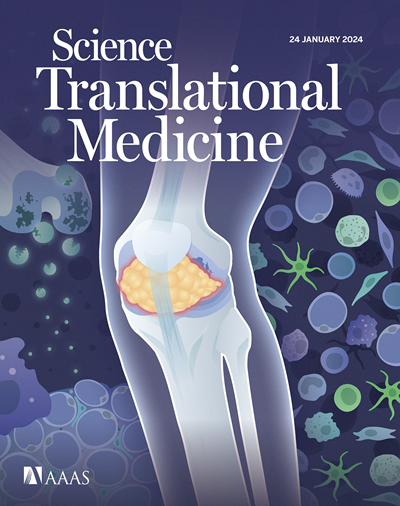精确分析和治疗异质白血病的剪接调控动力学
IF 15.8
1区 医学
Q1 CELL BIOLOGY
引用次数: 0
摘要
剪接因子突变强调了剪接失调在癌症中的作用;然而,它在缺乏这种罕见突变的情况下的影响仍然知之甚少。由于发现剪接独特地解决了癌症的遗传亚型,我们开发了一种称为OncoSplice的无监督计算工作流程,以全面定义肿瘤分子景观。在成人和儿童急性髓性白血病(AML)中,OncoSplice仅从剪接谱中确定了驱动基因谱,定义了十几种以前未报道的分子亚型,这些亚型在AML队列中复发,并发现了一个显性剪接亚型,部分表型U2AF1突变剪接。尽管儿童白血病缺乏剪接因子突变,但这种U2AF1样亚型相似地跨越了儿童和成人AML遗传,并始终预测预后不良。通过长读单细胞RNA测序,我们证实了发现的U2AF1样剪接在细胞状态下是共享的,选择了健康的昼夜节律基因程序,在复发时是稳定的,并诱导了白血病干细胞程序。药物抑制U2AF1样剪接调节因子PRMT5可挽救白血病剪接错误并抑制白血病细胞生长。最后,IRAK4基因缺失(U2AF1样蛋白和PRMT5治疗的共同靶点)在异种移植模型中阻断白血病的发展并诱导分化。这项工作表明,在没有选择突变的情况下,广泛的剪接失调是异质性白血病的治疗靶点。本文章由计算机程序翻译,如有差异,请以英文原文为准。
Splicing regulatory dynamics for precision analysis and treatment of heterogeneous leukemias
The role of splicing dysregulation in cancer is underscored by splicing factor mutations; however, its impact in the absence of such rare mutations remains poorly understood. Prompted by the finding that splicing uniquely resolved genetic subtypes of cancer, we developed an unsupervised computational workflow called OncoSplice to comprehensively define tumor molecular landscapes. In adult and pediatric acute myeloid leukemia (AML), OncoSplice identified the spectrum of driver genetics from splicing profiles alone, defined more than a dozen previously unreported molecular subtypes recurrent across AML cohorts, and discovered a dominant splicing subtype that partially phenocopies U2AF1-mutant splicing. Although pediatric leukemias lack splicing factor mutations, this U2AF1-like subtype similarly spanned pediatric and adult AML genetics and consistently predicted poor prognosis. Using long-read single-cell RNA sequencing, we confirmed that discovered U2AF1-like splicing was shared across cell states, co-opted a healthy circadian gene program, was stable through relapse, and induced a leukemic stem cell program. Pharmacological inhibition of an implicated U2AF1-like splicing regulator, PRMT5, rescued leukemia missplicing and inhibited leukemic cell growth. Finally, genetic deletion of IRAK4, a common target of U2AF1-like and PRMT5 treatment, blocked leukemia development in xenograft models and induced differentiation. This work suggests that broad splicing dysregulation, in the absence of select mutations, is a therapeutic target in heterogeneous leukemias.
求助全文
通过发布文献求助,成功后即可免费获取论文全文。
去求助
来源期刊

Science Translational Medicine
CELL BIOLOGY-MEDICINE, RESEARCH & EXPERIMENTAL
CiteScore
26.70
自引率
1.20%
发文量
309
审稿时长
1.7 months
期刊介绍:
Science Translational Medicine is an online journal that focuses on publishing research at the intersection of science, engineering, and medicine. The goal of the journal is to promote human health by providing a platform for researchers from various disciplines to communicate their latest advancements in biomedical, translational, and clinical research.
The journal aims to address the slow translation of scientific knowledge into effective treatments and health measures. It publishes articles that fill the knowledge gaps between preclinical research and medical applications, with a focus on accelerating the translation of knowledge into new ways of preventing, diagnosing, and treating human diseases.
The scope of Science Translational Medicine includes various areas such as cardiovascular disease, immunology/vaccines, metabolism/diabetes/obesity, neuroscience/neurology/psychiatry, cancer, infectious diseases, policy, behavior, bioengineering, chemical genomics/drug discovery, imaging, applied physical sciences, medical nanotechnology, drug delivery, biomarkers, gene therapy/regenerative medicine, toxicology and pharmacokinetics, data mining, cell culture, animal and human studies, medical informatics, and other interdisciplinary approaches to medicine.
The target audience of the journal includes researchers and management in academia, government, and the biotechnology and pharmaceutical industries. It is also relevant to physician scientists, regulators, policy makers, investors, business developers, and funding agencies.
 求助内容:
求助内容: 应助结果提醒方式:
应助结果提醒方式:


